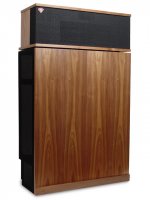...they become eight!
An externally hosted image should be here but it was not working when we last tested it.
Hi:
Corners are some of the worst places to get a stereo image, besides of a horrible reinforcement of bass tones.
Corners are some of the worst places to get a stereo image, besides of a horrible reinforcement of bass tones.
Except if you place them further from the corners the difference from the reflections will be larger and more out of phase. You choose 😉
Hugo Rodriguez said:Hi:
Corners are some of the worst places to get a stereo image, besides of a horrible reinforcement of bass tones.
Well, I don't think the idea is to put full-range speakers there, but subwoofers. Doing so will give 8 times the free field sound pressure, or +18 dB.
ShinOBIWAN said:Somebody was really bored.
Actually, no, this is stuff that I use when I teach. It is so much easier to understand the 7 mirror sources when you see them in mirrors like this.
Svante said:Actually, no, this is stuff that I use when I teach. It is so much easier to understand the 7 mirror sources when you see them in mirrors like this.
There's little more rewarding in this life than confusing kids

Have you tried sitting up against the back wall?Hugo Rodriguez said:besides of a horrible reinforcement of bass tones.
Svante said:
Well, I don't think the idea is to put full-range speakers there, but subwoofers. Doing so will give 8 times the free field sound pressure, or +18 dB.
Greets!
Hmm, each time you halve the radiation angle yields a doubling of SPL, or +3 dB, so if a sphere has a Q = 1, then a corner will have a Q = 8, or 10*log10(8) = ~ +9.03 dB, so the Directivity Index (DI) = 9.03. Since speakers are normally rated in half space though, max theoretical corner gain is only 10*log10(4) = ~ +6.02 dB.
GM
So how many would you have if you had a mirror ceiling?
all those mirrors remind me of my bedroom😀
all those mirrors remind me of my bedroom😀
Hmm, each time you halve the radiation angle yields a doubling of SPL, or +3 dB
Since SPL is amplitude, isn't a doubling +6dB?
Svante,
Nice illustration! This begins to show why small rooms are so acoustically difficult with their nearby surfaces and tendancy to multiply image sources. The wider a speaker's dispersion, the more damage is done to the direct-to-reflected energy ratio. This is why physically large speakers, especially front horns, can often perform better in corners than can mini-monitors. The higher directivity minimizes extraneous reflections in the midrange and treble.
Bill,
You are quite right... in this case the radiation angle has been halved 3 times... 18 dB.
🙂
You are quite right... in this case the radiation angle has been halved 3 times... 18 dB.
🙂
Attachments
GM said:
Greets!
Hmm, each time you halve the radiation angle yields a doubling of SPL, or +3 dB, so if a sphere has a Q = 1, then a corner will have a Q = 8, or 10*log10(8) = ~ +9.03 dB, so the Directivity Index (DI) = 9.03. Since speakers are normally rated in half space though, max theoretical corner gain is only 10*log10(4) = ~ +6.02 dB.
GM
What you say is (almost) true for short wavelengths (compared to the source-to-wall distance). Every time the angle is halved theintensity (not the sound pressure (and definitely not the sound pressure level)) is doubled. A doubling of the intensity means + 3 dB.
However, for long wavelengths, the sound pressure is doubled for every halving of the angle, and the level increases by 6 dB.
This means that when a woofer is put in a corner it actually radiates more acoustic power (at low frequencies) than it would in free space. It is not just that the power is concentrated to a spaller space, it actually increases too.
And yes, you are right in that speakers are normally rated in half space, I compared to free space. Compared to half space, the corner yields a boost of 12 dB for low frequencies.
Hmm Jeb-D, maybe you choose not to. I generally feel it doesn't hurt to embrace the corner where you design the speaker for that purpose. I feel you can either put it right in, or right out, or deal with standing waves and comb filtering (broadly speaking), and not that there's anything wrong with that BTW. 🙂Jeb-D. said:Nobody puts speaker in a corner.
Bill F. said:
Since SPL is amplitude, isn't a doubling +6dB?
Greets!
Rather than get bogged down in the somewhat confusing subject of the various sound pressure definitions, I'll let those interested start here: http://www.answers.com/topic/sound-intensity
Now getting back to what Svante said: '....... (corner loading) will give 8 times the free field sound pressure......'
This is correct in theory, so we can say that the corner makes one driver in free space with 'x' SPL sound like there are eight of them, and since for every doubling of identical SPL there's a ~3.01 dB increase, and as Poobah noted, this occurs 3x, we wind up with a theoretical ~ +9.03 dB.
GM
- Status
- Not open for further replies.
- Home
- Loudspeakers
- Multi-Way
- What happens when you put a loudspeaker in a corner?

